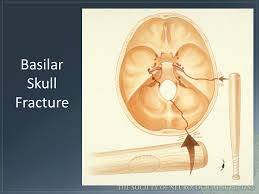CEN Basilar Skull Fracture
Basilar Skull Fracture Overview For CEN Exam
Overview
A basilar skull fracture (or basal skull fracture) is a fracture of the base of the skull, typically involving the temporal bone, occipital bone, sphenoid bone, and/or ethmoid bone. This type of fracture is rare, occurring as the only fracture in just 4% of severe head injury patients. Such fractures can cause tears in the membranes surrounding the brain, or meninges, with resultant leakage of the cerebrospinal fluid (CSF). The leaking fluid may accumulate in the middle ear space, and dribble out through a perforated eardrum (CSF otorrhea) or into the nasopharynx via the eustachian tube, causing a salty taste. CSF may also drip from the nose (CSF rhinorrhea) in fractures of the anterior skull base, yielding a halo sign. These signs are characteristic for basilar skull fractures.
Basilar skull fractures include breaks in the posterior skull base or anterior skull base. The former involve the occipital bone, temporal bone, and portions of the sphenoid bone; the latter, superior portions of the sphenoid and ethmoid bones. The temporal bone fracture is encountered in 75% of all basilar skull fractures and may be longitudinal, transverse or mixed, depending on the course of the fracture line in relation to the longitudinal axis of the pyramid.
Bones may be broken around the foramen magnum, the hole in the base of the skull through which the spinal cord exits and becomes the brain stem, creating the risk that blood vessels and nerves exiting the hole may be damaged.
Due to the proximity of the cranial nerves, injury to those nerves may occur. This can cause palsy of the facial nerve or oculomotor nerve or hearing loss due to damage of cranial nerve VIII.
Signs and symptoms
- Battle’s sign — bruising of the mastoid process of the temporal bone.
- Raccoon eyes — bruising around the eyes, i.e. “black eyes”
- Cerebrospinal fluid rhinorrhea
- Cranial nerve palsy
- Bleeding (sometimes profuse) from the nose and ears
- Hemotympanum
- Conductive or perceptive deafness, nystagmus, vomitus
- In 1-10% of patients, optic nerve entrapment occurs. The optic nerve is compressed by the broken skull bones, causing irregularities in vision.
- Serious cases usually result in death
Treatment
- Surgical Intervention
- Adults with simple linear fractures who are neurologically intact do not require any intervention and may even be discharged home safely and asked to return if symptomatic. Infants with simple linear fractures should be admitted for overnight observation regardless of neurological status.[25] Neurologically intact patients with linear basilar fractures also are treated conservatively, without antibiotics. Temporal bone fractures are managed conservatively, at least initially, because tympanic membrane rupture usually heals on its own.
- Simple depressed fractures in neurologically intact infants are treated expectantly. These depressed fractures heal well and smooth out with time, without elevation. Seizure medications are recommended if the chance of developing seizures is higher than 20%. Open fractures, if contaminated, may require antibiotics in addition to tetanus toxoid. Sulfisoxazole is a common recommendation.
Emergency Room Certification Courses
Overview
- Elite Reviews Offers A Variety Of Online Courses That Will More Than Adequately Help Prepare The Emergency Nurse To Pass The National Exam.
- Each Course Includes Continuing Education Credit and Sample Questions.
Continuing Education
- Each Of Our Online Courses Has Been Approved Continuing Education Contact Hours by the California Board of Nursing
- Login To Your Account In Order To Access The Course Completion Certificate Once The Course Is Complete.
CEN Free Trial
- FREE Sample Lecture & Practice Questions
- Available For 24 Hrs After Registration
- Click Free Trial Link To Get Started – CEN Free Trial
How It Works
How The Course Works
- First – Purchase The Course By Clicking On The Blue Add To Cart Button – You Will Then Be Prompted To Create A User Account.
- Second – After Creating An Account, All 3 Options (90, 120 or 150 Days) Will Be Listed. Select The Option You Desire And Delete The Other Two.
- Third – You Will Be Prompted To Pay For The Review Using PayPal – After Payment You Will Be Redirected Back To Your Account.
- Last – Click The Start Button Located Within Your Account To Begin The Program
- 175 Sample Questions
- Q & A With Rationales
- Approved For 5 CEU’s
- 90 Days Availability
- Cost $75.00
- 1250+ Sample Questions
- Q & A With Rationales
- Approved For 25 CEU’s
- 90 Days Availability
- Cost $200.00
CEN Practice Questions Bundle
- 1350+ Sample Questions
- Q & A With Rationales
- Approved For 30 CEU’s
- 90 Days Availability
- Cost $225.00
CEN Review Course
- Option 1
- Lectures & 1250+ Questions
- Approved For 35 CEU’s
- 90 Days Availability
- Cost $325.00
- Option 2
- Lectures & 2000+ Questions
- Approved For 40 CEU’s
- 90 Days Availability
- Cost $350.00
CEN Review Course Bundle
- Option 3
- Lectures & 3000+ Questions
- Approved For 70 CEU’s
- 90 Days Availability
- Cost $375.00








